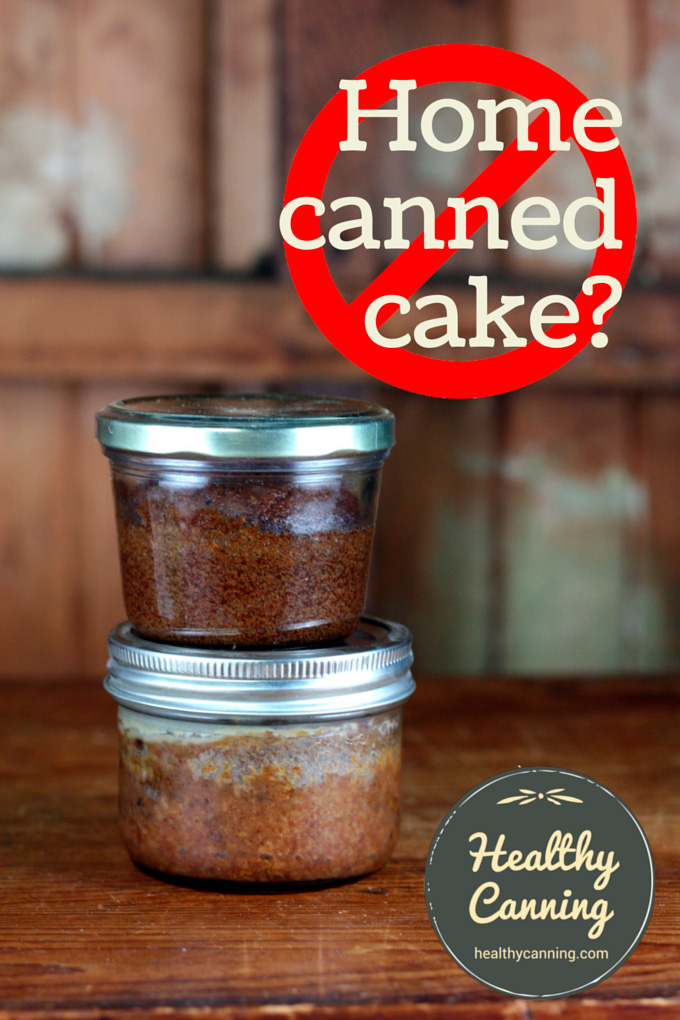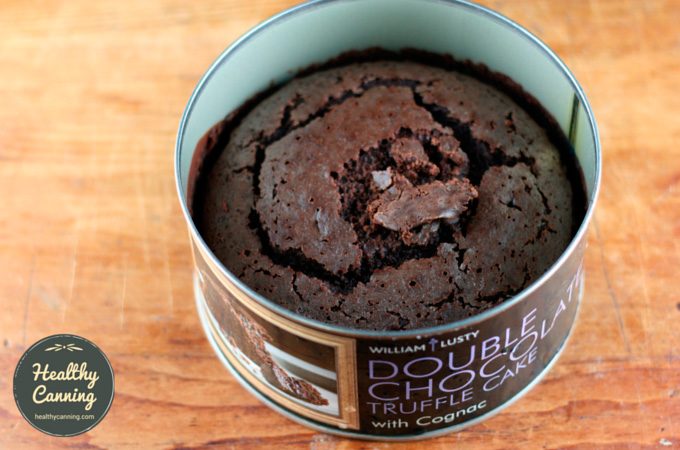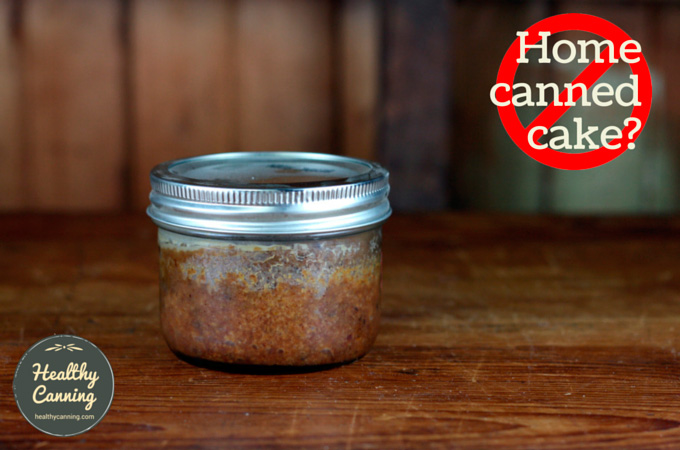You cannot safely home can bread or cake.
If someone gives you home canned cake, assume it is unsafe to eat and discard it in a manner that not even animals can consume it. See the USDA’s procedure for handling suspect food.
What is cake in a jar?
“Home-canned cakes” and “home-canned quick breads” are cakes or quick-breads that have been baked in, and then sealed in, a jar with a lid.
You can see such “home-canned cakes” and “home-canned quick breads” sold at fairs, farmers’ markets, and craft shows. The jars are unique and fun looking, are easily portable for lunches, and the single serving sizes seem ideal for singletons and people living alone. And besides, many people’s first reaction is, “how cute!”
In making them, cake batter is poured into canning jars, which are then baked in the oven. When the cake is deemed cooked by the cook, the jars are taken out of the oven, metal lids slapped on right away, and as the cake and jar cools a vacuum (usually) forms, creating a sealed jar. Recipes maintain that the cake is shelf-stable and can be stored anywhere from a year to indefinitely.
The first thing to note is that this isn’t actually “home-canned” cake, because there isn’t actually any canning that happens.
The bread or cake is not really home-canned. It is baked in an open glass canning jar and then covered with a canning lid; there is no further canning process given to the product.” [1] Elizabeth L. Andress, Ph.D., and Judy A. Harrison, Ph.D. Canning Breads and Cakes ? 2000: University of Georgia, College of Family and Consumer Sciences. FDNS-E-75
So they don’t actually undergo a canning process, which is heat-treatment of a canister of some sort holding food.
Secondly, Elizabeth Andress, project director of the National Center for Home Food Preservation (NCHFP), reminds us that just because we may see recipes or blogs encouraging people to do this does not mean it is safe:
… recipes for home-canned breads and cakes do continue to be available. They appear occasionally in major newspapers, in books, on television and on the web. Availability is not a guarantee that the finished product is safe, however.” [2] Elizabeth L. Andress, Ph.D., and Judy A. Harrison, Ph.D. Canning Breads and Cakes ? 2000: University of Georgia, College of Family and Consumer Sciences. FDNS-E-75
Utah State University Food Safety Specialist Charlotte Brennand emphatically says not to have anything to do with this:
DON’T CAN IT! DON’T EAT IT!” [3] Brennand, Charlotte P. Safety of Canning Quick Breads. USU Extension Food Safety/Preservation Specialist. Food Safety Fact Sheet. October 2000 FN-FS-250.10
Commercially-made cake in a jar
You may also see commercially-made and sold ones in stores.
The commercially made “cakes in a jar” that are sold without sealed tops, and kept refrigerated in chillers, are fine, and there is no question of concern about those, beyond the usual best-before dates.
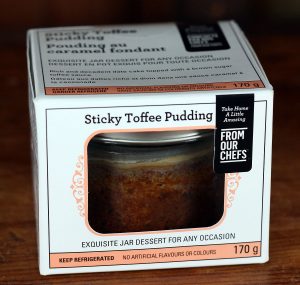
This commercial cake in a jar is sold in chillers and has directions on both front and top of the box to keep refrigerated. Click to enlarge
The shelf-stable ones made by large food companies and sold in grocery stores are also considered fine: they will have added rafts of preservatives and additives only available commercially to make it safe.
You will see these products made commercially; however additives, preservatives and processing controls not available for home recipes are used.” [4] Andress, Elizabeth L. and Judy A. Harrison. So Easy to Preserve. University of Georgia Cooperative Extension. Bulletin 989. Sixth Edition. 2014. Page 117.
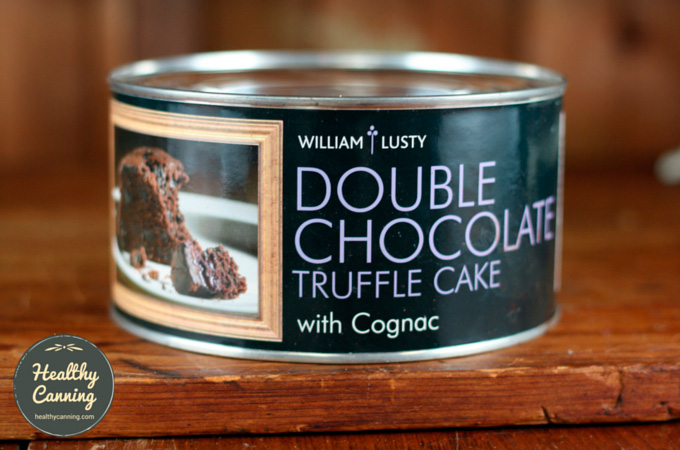
Cake commercially canned by a large professional food company.
If you don’t see preservatives on the list of ingredients, then, it’s possible that it was a combination of process control and strictly regimented recipe formulation that made them safe. Or, you may want to avoid these as well all together.
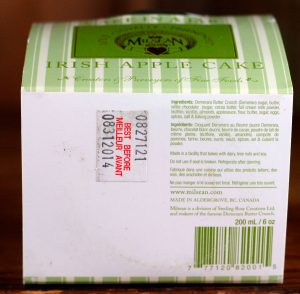
Sample shelf-stable commercial cake in a jar ingredients. No preservatives are present so presumably safety was achieved through formulation and process controls. Click to enlarge.
What is the risk?
The risk is the big B word — botulism.
These products present the risk of food poisoning from botulism toxin.” [5] Ingham, Barb. Canned Breads and Cakes an Unsafe Holiday Gift. Blog posting. 10 November 2017. Accessed November 2017 at https://fyi.uwex.edu/safepreserving/2017/11/10/canned-breads-and-cakes-an-unsafe-holiday-gift/.
This has been confirmed by dedicated research studies:
Some research studies have shown that low acid canned bread or cake products may have characteristics that are favorable for growth of Clostridium spores.” [6] Penn State University Extension. Canned Breads and Cakes. Accessed July 2016.
Charlotte Brennand from Utah State says that, it would be hard to think of any better breeding grounds for botulism in fact, than home canned breads and cakes:
Three factors determine if C. botulinum will grow or not: a nonacid pH, adequate moisture and an airless environment. Canned breads meet all the requirements. Normally these products are not being held under vacuum and therefore botulism is not a concern. However, sealing the bread in a jar provides the necessary airless condition.” [7] Brennand, Charlotte P. Safety of Canning Quick Breads. USU Extension Food Safety/Preservation Specialist. Food Safety Fact Sheet. October 2000 FN-FS-250.10
Given the high-stakes of giving someone botulism, and given that no safe home canning recipes have been developed, Elizabeth Andress and Judy Harrison from the University of Georgia say, don’t do it:
Given that no reliable, safe recipes for baking and sealing cakes or breads in jars for room temperature storage are available to the home cook, it is best to say these products are not recommended at this time.” [8] Elizabeth L. Andress, Ph.D., and Judy A. Harrison, Ph.D. Canning Breads and Cakes ? 2000: University of Georgia, College of Family and Consumer Sciences. FDNS-E-75
Remember, several strains of botulism are invisible. Foods spoiled by other bacteria are friendly by comparison, because your eyes and common sense will tell you not to eat them. You don’t get that warning with botulism infested foods. They can look, smell and taste fine.
To date, there are as of yet no documented cases of botulism resulting from cake in a jar. But again, all the experts are warning it’s an accident waiting to happen. Imagine how you would feel if you were the one who made the home canned cake in a jar that made someone incapacitated for life, or worse.
Baking in jars in an oven
What if you don’t seal the jars, but rather just bake your homemade treat in a canning jar, then store it in a fridge?
Don’t even mention that to Ball or Bernardin. They have a bird when you mention baking in their jars. Their jars are made of annealed glass, not Pyrex. The jars are certified for moist heat achieved from canning using boiling water, steam or pressure canning, not for dry oven heat, and they may fracture, shatter or explode in an oven, or be weakened enough that they will inexplicably shatter in someone’s hands later.
Ball says,
We do not recommend baking in any size or shape of Ball or Kerr canning jars. The glass used for Ball and Kerr canning jars is not tempered for oven use and is not meant to be used as bakeware.” [9] Ball. FAQ. Accessed July 2016 at https://www.freshpreserving.com/faqs.html
Bernardin says,
Not only is it unsafe, oven-canning can be extremely hazardous. Regardless of the brand of oven, jar, cap or lid you use, jars can break or explode due to temperature fluctuations when the oven door is opened.” [10] Bernardin. FAQ under: “How do different canning methods affect the safety of home canned foods?” Accessed July 2016.)
To be clear what this means for you, Elizabeth Andress of the NCHFP points out that it means that you’re on your own for any injury or damage from shattering or exploding glass, you will not be able to hold those companies liable:
…..canning jar manufacturers do not currently endorse baking in their canning jars. They would not be liable for any damage or illness that occurs from a non-recommended use of their jars. [11] Elizabeth L. Andress, Ph.D., and Judy A. Harrison, Ph.D. Canning Breads and Cakes ? 2000: University of Georgia, College of Family and Consumer Sciences. FDNS-E-75
Some of the refrigerated commercial ones you buy have directions on them asking you to heat them up (with metal lid off) in the microwave. It’s unclear what Ball or Bernardin would say about microwave use of their jars, either.
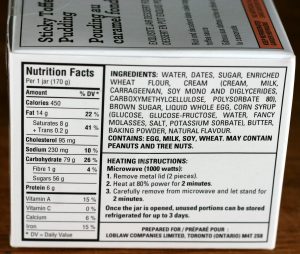
Directions indicating cake in a Bernardin mason jar to be heated in microwave. It’s unclear what Bernardin’s stance on that would be. Click to enlarge.
Refrigerated cakes and breads in jars
Penn State Extension gives this advice (citing Dr Angie Fraser from North Carolina State). They basically say that if you really are bound and determined to give cake in a jar as a present, make sure there is no vacuum seal on the jar, and give it as a refrigerated product.
If breads or cakes are baked in canning jars, seal them after they are completely cooled so that a vacuum seal is not created. This will prevent the growth of Clostridium botulinum. Also, immediately refrigerate. Refrigeration temperatures will prevent the growth of other harmful bacteria that can grow at the water activity and pH typically found in these types of products. The shelf-life in the refrigerator is several weeks.” [12]PennState Canning and Freezing FAQ. Accessed December 2017 at https://extension.psu.edu/canning-and-freezing-questions-and-answers#section-28
They note that regardless, there’s a risk of having the jars crack in the oven during baking.
You would want to make sure that the recipient knows what the shelf life is, and, that it does need to be kept refrigerated.
Alternatives to bottling your cake
There are many sayings about foolish people using the wrong tool for the wrong job. One such saying is, “if all you have is a hammer, everything looks like a nail.”
This could apply to people with an empty jar and a lid, and thinking that that makes everything look like it should be sealed inside that jar.
A sealed jar at room temperature is not the right storage method for cake or bread.
Instead, consume these items fresh, or frozen.
Barb Ingham from the University of Wisconsin says,
Instead, choose cake or bread recipes that you can freeze….. Quick breads are best eaten fresh, or placed in the freezer for long-term storage.” [13]Ingham, Barb. Canned Breads and Cakes an Unsafe Holiday Gift
Charlotte Brennand from Utah State agrees: enjoy it fresh, or freeze it.
Banana nut bread, zucchini bread or similar products should be either fresh or frozen.” [14] Brennand, Charlotte P. Safety of Canning Quick Breads. USU Extension Food Safety/Preservation Specialist. Food Safety Fact Sheet. October 2000 FN-FS-250.10
If you really want to give someone the idea of a cake in a jar, Clemson University has a really unique and crafty alternative. Given them a beautifully layered “mix in a jar”:
….prepare the ingredients of the cake or bread as a ‘mix in a jar.’ Layer the dry ingredients for a quick bread or cake into a jar and attach the directions for baking it to the outside. Include a ‘use by’ date on the label because ingredients such as baking powder will lose their effectiveness over time; brown sugar will harden when combined with other ingredients, and moisture from nuts and raisins can cause dry ingredients to cake. Ingredients for a topping, as on a coffee cake, can be inserted into a small plastic bag and placed on top of the other dry ingredients. One month from the time you prepare a ‘mix in a jar’ is an appropriate ‘use by’ date.” [15] Clemson University Extension Service. Cakes and Breads in Jars – Are They Safe?Accessed July 2016.
History of “cake in a jar” studies
To be clear: As with all historical research presented by HealthyCanning, none of the recipes or recommendations in this section are to be followed. The information here is for academic background purposes only.
Two newspaper columnists refer to the cake in a jar concept being a creation of Penn State University during World War Two.
In 1987, Vivian Calvillo, a Master Food Preserver, wrote:
Baking quick breads in canning jars as a means of preservation was common during World War II. Interest in this process has recently been revived.” [16] Calvillo, Vivian. Master Food Preservers Column. In: Placerville Mountain Democrat. Placerville, California. 14 January 1987. Page B-2.
In 1994, Marsha Parker, a Kentucky Extension Agent, wrote:
… bread in a jar has been around for a long time. Penn State University developed recipes for breads baked in jars so they could be sent to the troops overseas during World War II.” [17] Parker, Marsha. Canned bread now made for novelty. Hopkinsville, Kentucky: Kentucky New Era. 5 November 1994. Page 7A
HealthyCanning has been unable to date (2016) to find any primary source material which would back their assertions about a World War Two origin.
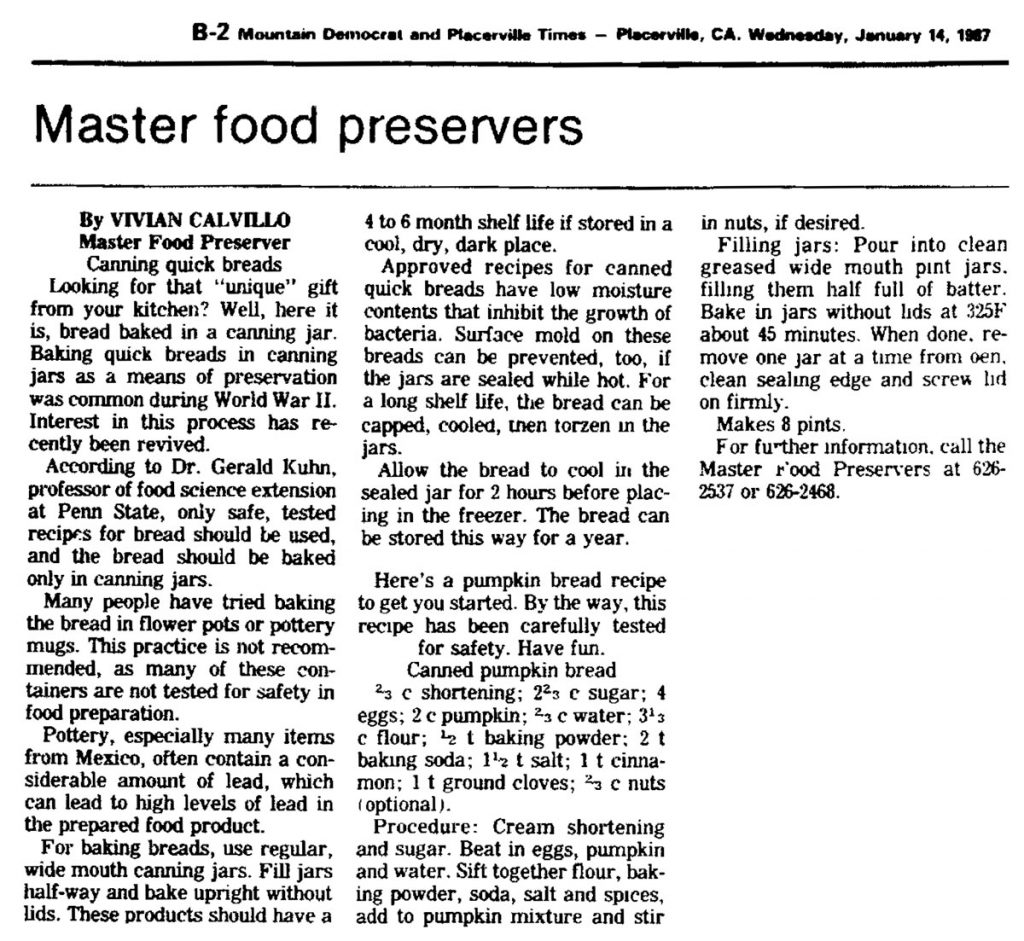
Calvillo, Vivian. Master Food Preservers Column. In: Placerville Mountain Democrat. Placerville, California. 14 January 1987. Page B-2. Click to enlarge.
Marsha Parker asserted in 1994 that in the years since the war, the recipes had been altered by being passed from one person to another, which could make them unsafe, and thus she was running the two Penn State originals: Pumpkin Bread, and Applesauce Cake.
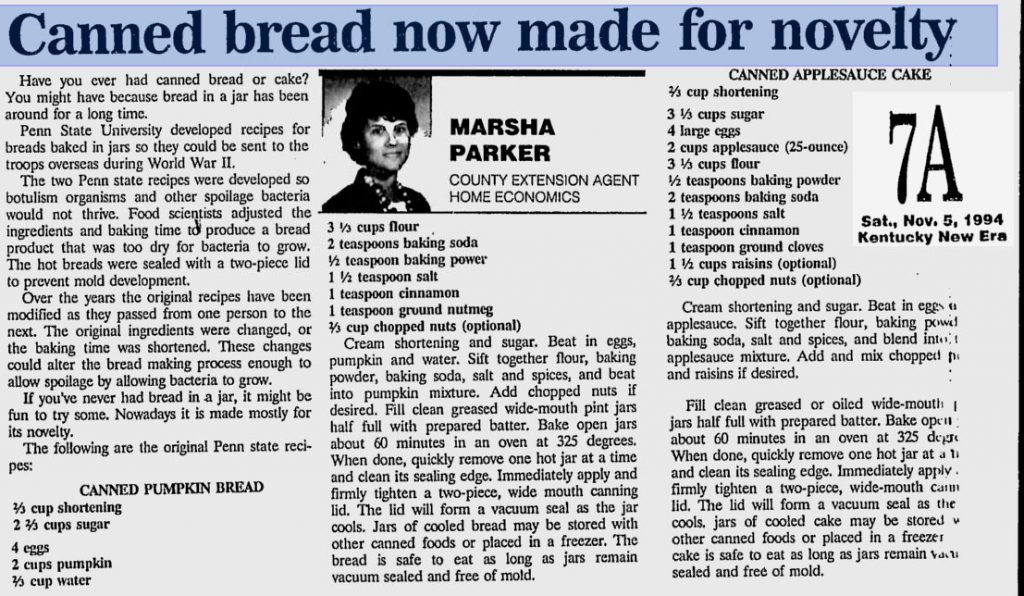
Parker, Marsha. Canned bread now made for novelty. Hopkinsville, Kentucky: Kentucky New Era. 5 November 1994. Page 7A. Click to enlarge.
Some people instead attribute the recipes to Gerald Kuhn. “It was developed by Gerald Kuhn, retired professor of food science at Penn State.” [18]Martinson, Suzanne. Canned Pumpkin Bread. Post Gazette, Pittsburgh, Pennsylvania. 10 November 2002.
Healthy Canning has been unable to date (2016) to find any primary source material which would back assertions about development by Gerald Kuhn personally, though Penn State itself does say:
Several years ago, a professor of Food Science at Penn State developed a recipe for canned bread. It was carefully formulated so that acid and moisture levels would prevent the growth of Clostridium botulinum spores during room temperature storage. The product can be safely made as long as the original Penn State recipe is followed exactly as written.” [19]Penn State University Extension. Canned Breads and Cakes. Accessed July 2016.
This does not say it was actually Gerald Kuhn. Nor have we have able to find a primary source copy of such a recipe to compare it with what appeared in the newspaper clippings above.
So we have been unable to verify the World War Two story, unable to confirm a Gerald Kuhn origin, and unable to find an actual Penn State issued copy of such a recipe. So we are not in possession of a clear chain of evidence that what appeared in the newspapers, warning people not to deviate, didn’t deviate itself.
In any event, the idea was that the two recipes had the right finely-balanced combination of acidity and low water activity that would be safe baked in jars (aside from the safety factor of the glass jars themselves in the oven) and then sealed in them.
The recipes have since been retracted. It was apparently decided that the risk was too great that home cooks would not follow the recipe rigorously: that they’d make substitutions, make mis-measurements over or under, forget something, or, try to be creative.
However, there is a significant risk that the creative cook may make ingredient substitutions or omissions that could significantly change the pH of the product such that conditions might be more favorable for growth of Clostridium spores.” [20]Penn State University Extension. Canned Breads and Cakes. Accessed July 2016.
In 1994, researchers at Kansas State University tested a banana-nut bread recipe.
Testing was done using spores of Clostridium sporogenes bacteria as a stand-in for botulism spores. Spores of this survived the baking process in the jars even at an oven temperature of 204 C for 50 minutes. In fact, even in test breads in jars that weren’t inoculated with the test spores, other spores that just happened to be naturally present survived and germinated. The test team recommend that further work would be needed in order to determine any kind of safe processing procedure. (Reported in the Journal of Food Protection in October 1994.)
So that’s why the recipes were withdrawn. There was just too great a risk that home cooks would deviate, on purpose or by accident, and, research work showed there could easily be bacterial growth in deviations occurred or other recipes were tried.
Further reading
Penn State University Extension. Canned Breads and Cakes. Accessed July 2016. (Note: the Penn State piece can give the impression that the 1994 testing research was done at Penn State. It was done at Kansas State University.)
Aramouni, F.M., Kone, K.K., Craig, J.A. and Fung, D.Y.C. (1994). Growth of Clostridium sporogenes PA 3679 in Home-Style Canned Quick Breads. Jn. of Food Protection 57(10):882-886.
References

